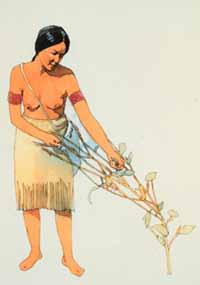
 |
Artist's illustration of a woman collecting seeds. |
Middle Woodland gardeners cultivated squash and gourd as Archaic Indians had done, but they also domesticated several native plants that are considered to be weeds today. Building on their knowledge of native plants, Middle Woodland people began to establish gardens of goosefoot (Chenopodium bushianum) marshelder (Iva annua), little barley (Hordeum pusillum), maygrass (Phalaris caroliniana), and squash (Cucurbita). They saved seeds in the autumn and planted them in their gardens the next spring. Eventually, they became increasingly committed to particular plots of land and created a way of life organized around both wild and domesticated plants.
At least 2,000 years ago American Indians domesticated tobacco.
Corn, a plant domesticated in Mexico, became an important part of the Late Woodland diet about 1,300 years ago.
Why did Native Americans cultivate plants for food? Some
archaeologists believe increases in human population encouraged Native Americans to search for more reliable sources of food. The complete answer is probably much more complicated, especially when you consider that a gardening way of life requires more time and effort than hunting and gathering.
Woodland period hunters and gatherers also made greater use of food found near their villages. Their diet included terrestrial animals like white-tailed deer (Odocoileus virginianus), rabbit (Sylvilagus), squirrel (Sciurus), raccoon
(Procyon lotor), and turkey (Meleagris gallopavo); many of which were important in the Archaic Period diet. Woodland people also increased their consumption of aquatic foods, including fish, freshwater mussels, turtles, and waterfowl. These animals were found in streams, rivers, and large, shallow lakes created by flood waters.
Woodland gatherers also collected a variety of tubers, nuts, and fruits. Groundnut (Apios americana), a member of the pea family, is a herb native to Illinois that was eaten fresh, boiled or roasted. Hazelnut (Corylus americana) and thick-shelled hickory (Carya) nut also provided food. Fruits in the Woodland diet included grape (Vitis), sumac (Rhus), blackberry (Rubus alumnus), elderberry (Sambucus canadensis), plum or wild black cherry (Prunus), persimmon (Diospyros virginiana), and others.
|
|
Copyright © 2000 Illinois State Museum